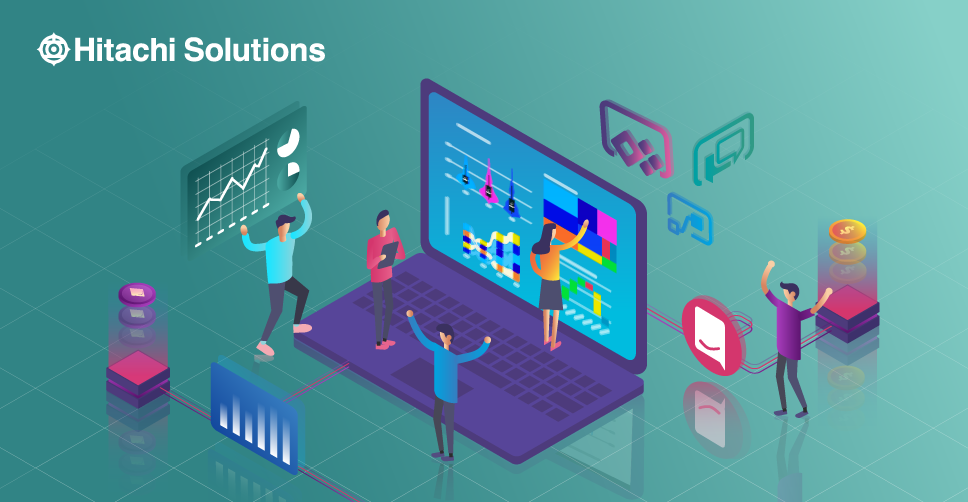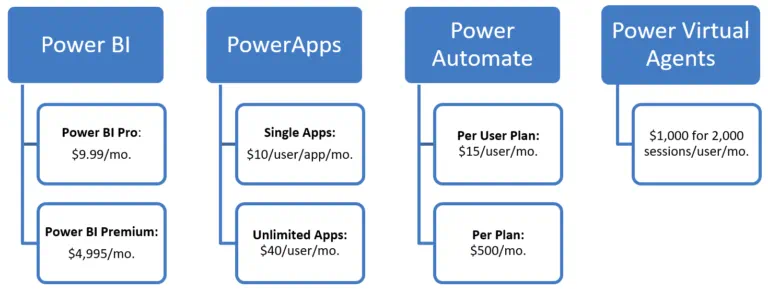

Opening Doors with Power Platform
Why you should be using Power Apps and Automate in your Dynamics 365 deployment
Watch the On-Demand WebinarMicrosoft launched its Power Platform in October 2019 to great fanfare — at long last, Microsoft finally had its own cloud computing product suite designed to go toe-to-toe with Amazon Web Services. Early reviews have been promising as users begin to uncover Power Platform’s application building and data analytics capabilities.
Curious whether Microsoft Power Platform could be a worthy investment for your business? Read on to learn more about this innovative app suite.
What is Microsoft Power Platform?
Power Platform consists of four applications or components:
Power-Bi
- Power BI: Microsoft Power BI is a cloud-based business analytics solution designed to help organizations “turn unrelated sources of data into coherent, visually immersive, and interactive insights.” With Power BI, users can pull data from multiple sources — for example, an Excel spreadsheet and a database — and use it to create easy-to-understand data visualizations that provide a 360-degree view into business operations.
Power-Apps
- PowerApps: Microsoft PowerApps is a program that leverages the low-code technique to democratize software development. Rather than manually program line after line of code, PowerApps users can quickly design and develop apps by dragging and dropping components into a flowchart-style formation. PowerApps users have their choice of two application types: canvas apps and model-driven apps.As their name implies, canvas apps provide the user with a blank canvas on which they can design a user interface using drag-and-drop components. Once they are satisfied with their design, the user can connect it to one or more data sources to complete its development. With model-driven apps, users start by choosing which data they want to use. Based on that data, PowerApps will generate a premade design template for the user; users still have the ability to edit individual components of that template, though model-driven apps are typically more rigid than canvas apps.Although they’re best-suited for different purposes, canvas apps and model-driven apps work best when used at different stages within the same development cycle.
Power-Automate
- Power Automate: Originally known as Microsoft Flow, Power Automate brings design logic to applications created in PowerApps. Similar to PowerApps, Power Automate is designed to democratize automation through the power of Robotic Process Automation and enables users to build complex, automated business and process workflows, which are triggered by insights from Power BI.
Power-Virtual-Agent
- Power Virtual Agents: The newest addition to the Power Platform, Power Virtual Agents enables users to build their own virtual agents — that is, chatbots — using a guided, no-code graphical interface. Users can also integrate Power Virtual Agents into existing systems using prebuilt connectors or custom Power Automate workflows for a more connected experience.
All four of these applications sit on top of and pull data from Common Data Service (CDS), Microsoft’s underlying data storage and management platform.
How Does It Work?
To get a better understanding of how the components that make up Power Platform function as a whole, let’s walk through a hypothetical use case.
Say hello to Sarah. Sarah is a sales associate at a jeweler who is helping a customer select a piece of jewelry to give to his wife for their anniversary. The customer has a vague idea of what his wife might like — a necklace — but doesn’t have a specific item in mind, so Sarah uses a PowerApps on her tablet to show him a side-by-side of all the different comparison the store sells, including their features, price, and availability.
Once the customer finds an item that he knows his wife will love, Sarah uses Power Automate to automatically send him a confirmation email with all of the details of his purchase. The email includes a link to open a chat with a virtual assistant, set up by the company using Power Virtual Agents, to answer any follow-up questions.
Finally, Sarah uses Power BI on her tablet to see visualizations of advanced queries in her data set, such as which items are being sold, at what volume, the net revenue generated from these sales, and so on. She uses these insights to inform how she handles future sales and improve her performance.
The Value of the Power Platform
In addition to CDS, Power Platform can extract data from any number of external data sources, such as Twitter, Google Analytics, and LinkedIn; it also integrates with Office 365, Dynamics 365, and Azure. The ability to pull data from various sources is only part of what makes Microsoft Power Platform so important, though.
What really makes Power Platform shine is its approach to data democratization. The power to analyze data and build and automated applications no longer rests solely in the hands of IT departments and development teams — now, even those who are new to the Microsoft ecosystem can build custom solutions that contribute to workplace innovation. There are numerous benefits to this:
- Businesses save time and money that would otherwise be spent submitting IT requests or hiring developers
- Employees have the ability to become citizen developers and to feel more empowered in their roles
- Business are able to make the most out of their existing data
- Stakeholders gain a 360-degree view into business operations, as well as access to real-time data
- IT departments and developers are able to focus on more important tasks, rather than manual or mundane ones
Based on this information, it’s easy to understand why Power Platform is such an integral part of Microsoft’s business strategy. Although it’s still early yet, it already looks like Power Platform is going to have a very bright future.
Power Platform Licensing, Pricing & More
Microsoft does not, as of yet, offer a licensing bundle for the Power Platform; instead, users must purchase Power BI, PowerApps, and Power Automate licenses separately.
We’ve outlined the pricing tiers for each in the chart below:

Microsoft Power Platform + Hitachi Solutions: A Winning Combination
As a gold-certified Microsoft partner and early adopter of Power Platform technologies, Hitachi Solutions has a winning record of helping our clients leverage the Microsoft Power Platform to enhance and extend their Dynamics implementation, as well as other IP assets, bringing them one step closer to digital transformation. Find out exactly what makes Hitachi Solutions and the Power Platform a winning combination by talking to one of our specialists today.


